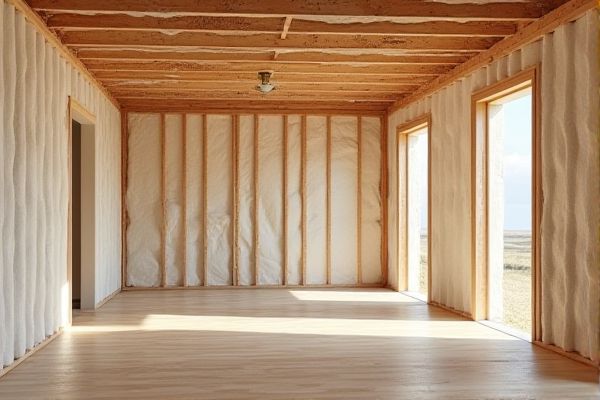
Rigid foam insulation offers superior thermal resistance and moisture resistance compared to fiberglass, making it ideal for areas prone to dampness or where high insulation value is required in a thin layer. Discover the advantages and best applications for each material to choose the most effective solution for your insulation needs by reading the rest of the article.
Table of Comparison
| Feature | Rigid Foam Insulation | Fiberglass Insulation |
|---|---|---|
| Material Type | Polyurethane, Polystyrene, or Polyisocyanurate panels | Glass fibers made into batts or rolls |
| R-Value per Inch | 4.5 - 8.0 | 2.2 - 3.8 |
| Moisture Resistance | High; acts as vapor barrier | Low; can absorb moisture |
| Installation | Rigid panels, cut to size; requires sealing of joints | Flexible batts; easy to install between studs |
| Durability | Long-lasting; resists mold and decay | Prone to settling and compression over time |
| Cost | Higher upfront cost | Lower cost, budget-friendly |
| Air Sealing | Effective air barrier when properly installed | Requires additional air barrier materials |
| Environmental Impact | Can contain blowing agents with global warming potential | Recyclable and less harmful |
| Common Uses | Walls, roofs, foundations, exterior insulation | Attics, walls, floors, interior insulation |
Introduction to Rigid Foam Insulation and Fiberglass
Rigid foam insulation offers superior thermal resistance and moisture resistance compared to traditional fiberglass, making it ideal for exterior walls, roofs, and foundations. Fiberglass insulation remains popular for its affordability and ease of installation, commonly used in attic spaces and interior walls. Your choice depends on factors like R-value requirements, installation environment, and long-term durability needs.
Material Composition and Structure
Rigid foam insulation consists primarily of polystyrene, polyisocyanurate, or polyurethane, featuring a closed-cell structure that provides higher thermal resistance and moisture resistance compared to fiberglass. Fiberglass insulation is made from fine glass fibers arranged in a loose, layered mat, which allows for sound absorption but can trap moisture and compress over time, reducing its effectiveness. Your choice between these materials should consider the specific insulation needs, such as durability, moisture control, and thermal performance.
Thermal Performance and R-Value Comparison
Rigid foam insulation typically offers higher thermal performance and R-values per inch compared to fiberglass insulation, making it more effective at reducing heat transfer. Polyisocyanurate rigid foam provides R-values around 6 to 6.5 per inch, while extruded polystyrene (XPS) ranges from 5 to 5.5, significantly outperforming fiberglass batts, which generally have R-values between 3.1 to 3.4 per inch. The superior R-value of rigid foam insulation contributes to enhanced energy efficiency and better temperature regulation in building envelopes.
Moisture Resistance and Mold Prevention
Rigid foam insulation offers superior moisture resistance compared to fiberglass due to its closed-cell structure, which prevents water infiltration and reduces the risk of mold growth. Fiberglass insulation, being porous, can trap moisture and create a breeding ground for mold and mildew if exposed to damp conditions. Using rigid foam insulation in areas prone to humidity or water exposure significantly enhances mold prevention and overall indoor air quality.
Installation Process and Ease
Rigid foam insulation offers a straightforward installation process with large panels that are easy to cut and fit precisely into wall cavities, reducing gaps and air leaks. Fiberglass insulation requires careful handling and protective gear, as its loose fibers can irritate the skin and lungs, and installations must be painstakingly measured and packed to avoid compression or voids. Choosing rigid foam can simplify your project by minimizing installation time and improving energy efficiency through a tighter seal.
Cost Analysis and Long-Term Value
Rigid foam insulation generally has a higher upfront cost compared to fiberglass but offers superior thermal resistance and moisture resistance, leading to lower energy bills over time. Fiberglass insulation is more affordable initially but may require more frequent replacement or maintenance due to potential moisture absorption and reduced efficiency. Evaluating long-term value favors rigid foam insulation in climates with significant temperature fluctuations or moisture exposure, where durability and energy savings offset the initial investment.
Durability and Lifespan
Rigid foam insulation offers superior durability and a longer lifespan compared to fiberglass, resisting moisture, mold, and compression over time. Its closed-cell structure maintains thermal performance even in harsh conditions, making it ideal for areas prone to dampness or heavy use. Choosing rigid foam can extend your insulation's effectiveness and reduce maintenance or replacement frequency.
Environmental Impact and Sustainability
Rigid foam insulation typically has a higher environmental impact due to its reliance on petrochemical-based materials and blowing agents that may contribute to global warming, whereas fiberglass insulation is made primarily from recycled glass and sand, offering better sustainability. Fiberglass presents fewer emissions during manufacturing and is often recyclable, making it a greener choice for eco-conscious construction. However, rigid foam's superior thermal performance can reduce energy consumption, indirectly lowering carbon footprints over the building's lifespan.
Applications and Best Use Cases
Rigid foam insulation excels in environments requiring high moisture resistance and superior thermal performance, making it ideal for exterior walls, foundations, and roof assemblies. Fiberglass insulation is best suited for interior applications like walls, attics, and crawl spaces where cost efficiency and ease of installation are priorities. Rigid foam provides continuous insulation that prevents thermal bridging, while fiberglass is often used as batt insulation for framing cavities to improve energy efficiency in residential and commercial buildings.
Conclusion: Choosing the Right Insulation for Your Needs
Rigid foam insulation offers superior thermal resistance and moisture control, making it ideal for areas requiring high energy efficiency and moisture protection. Fiberglass insulation is cost-effective and easier to install, suitable for standard applications where budget constraints are key. Your decision should balance performance requirements, budget, and installation environment to select the most effective insulation for your project.
 homyna.com
homyna.com